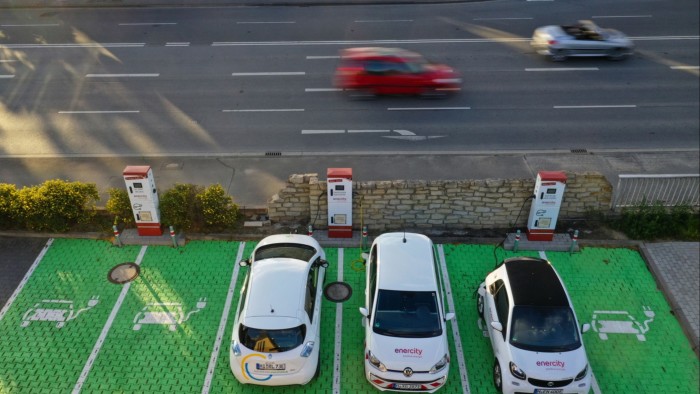Wireless charging offers hope for mass electric vehicle use

Simply sign up to the Electric vehicles myFT Digest -- delivered directly to your inbox.
An hour’s drive south of Stuttgart lies a modest stretch of road that may represent the future of electric vehicle charging.
This kilometre-long strip in the German town of Balingen will, later this year, host the world’s first public trial of “wireless charging”. Its aim will be to show that a technology long regarded as ambitious and futuristic can now work in the real world.
Several carmakers, including BMW, already offer vehicles with pads that allow them to recharge when parked. But the potential for refuelling batteries while driving — known as dynamic charging — has widespread implications for the industry.
Chief among these is reducing the size of the batteries needed in vehicles to avoid dreaded “range anxiety” — which remains one of the greatest barriers to widespread electric vehicle adoption.
Carmakers and industry lobby groups have been warning that far too few charging points are being put in to serve the expected number of electric vehicles on the roads. They have also expressed concern about a potential shortage of battery materials by, or shortly after, the middle of the decade.
However, analysts believe that dynamic charging — which allows vehicles to carry much smaller batteries — would enable limited resources to be used across more vehicles.
“The aim of this project is not only to open up wireless charging to the public in Germany,” says Andreas Wendt, chief executive of the German arm of Electreon, an Israeli group that provides the charging system. “Other significant aspects include the development and use of a tool that will assist public transportation planners in where to install the inductive infrastructure for a specific town or region.”
Early trials show “how effective, safe, and easy to deploy wireless dynamic charging is,” Wendt adds. “We hope this is the start of many more projects on public and private roads in Germany.”
As vehicle manufacturers ramp up their production of battery models to meet tightening emissions regulations, dynamic charging — if proven to work at scale and cost effectively — therefore offers a solution to the lack of static charging points.
“A wireless in-road charging system will be revolutionary for EVs by potentially extending an EV’s battery charge without having to stop and plug in,” argues Michele Mueller, from Michigan’s Department of Transportation, which is also trialling the technology this year.
These first road trials largely feature buses — which run on fixed routes, making them easier to control — as well as some taxis, which can charge from pads placed under ranks at airports or train stations.
“The adoption of this technology will be in a fleet, or captive fleet, first, because it’s exponentially harder when you go to private cars,” explains Michael Hurwitz, future mobility specialist at professional services firm PA Consulting. Hurwitz was previously head of innovation at Transport for London, the local government body responsible for most of the transport network in the UK capital.
“If you have operational charging, rather than at the end of a route, then the battery size you need and the very significant cost of the vehicle goes down.”
But there are still significant hurdles for the technology to clear before it is proven.
Parts have to be interoperable, allowing rival vehicle models to charge on the same system to avoid duplicating the technology. Installing underfloor charging pads, meanwhile, can be prohibitively expensive.
Then there is the wider challenge of getting highway operators to co-ordinate with energy grids, and the wider automotive industry.
Hurwitz suggests the best chance for the technology is to have it “wrapped into the way we build and maintain roads, both commercially and operationally — if any highways are going to make it work, it’s intensively used freight corridors.”
However, the need for a high-speed electricity connection can make achieving widespread on-the-road charging too difficult.
When FirstBus, the UK’s second largest regional bus operator, which is in the process of electrifying its fleet, looked at wireless charging it concluded the project was too expensive, because of the need to feed power to its many rural bus stops.
“It’s all about the power supply,” says Garry Birmingham, FirstBus director of decarbonisation. “Some bus stops don’t even have a light in them.” The company was quoted £70,000 for each ground-based charging pad.
Even so, the technology is expected to make some inroads this decade. Technology research group IDTechEx predicts there will be around 700,000 wirelessly charged vehicles owned by premium car drivers in 2032, “because of the added convenience of not having to plug in”.
It expects about 180,000 of these to be electric delivery vans, as “limited space in depots will need non-intrusive wireless solutions so that vans can be charged and loaded with cargo at the same time.” IDTechEx also says: “Transit buses are also good candidates for adoption but are much smaller in unit volume.”
Carmakers are already dipping their toes into the technology. Fiat owner Stellantis has been testing dynamic charging on a private track since 2021, while Volvo Cars last year announced it will trial wireless charging on its XC40 electric models.
Mats Moberg, who was head of research and development at Volvo at the time of the announcement, said: “Testing new charging technologies together with selected partners is a good way to evaluate alternative charging options for our future cars.”

Comments